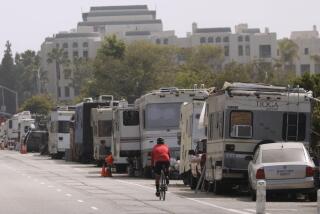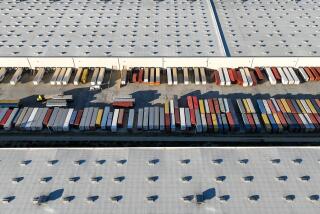Bill that would allow giant digital billboards in downtown L.A. draws heat
Reporting from Sacramento — State lawmakers have resurrected a controversial bill that could allow developers to erect several giant electronic billboards around the $1-billion Metropolis high-rise project in downtown Los Angeles.
The measure by Assemblyman Miguel Santiago (D-Los Angeles) is aimed at helping the economic revitalization of a downtown neighborhood, but opponents say it will create visual blight and a traffic hazard in a heavily traveled area of the city core.
Santiago said that when the state closed down redevelopment agencies a few years ago, it made it harder to provide financial incentives to get developers to revitalize inner cities. Billboards can provide extra revenue to help make developments more profitable.
“We really saw an opportunity in a legislative discussion about market-based incentives to spur much-needed economic activity downtown and recruit and retain investment and create jobs in the downtown Los Angeles area,” Santiago said.
The measure stalled last September in the Senate Transportation and Housing Committee amid opposition, but the bill has been scheduled for an urgency hearing by the panel on Tuesday.
“Bad bills never seem to die. They come back up,” said Dennis Hathaway, president of the Coalition to Ban Billboard Blight. “It’s a lot of electronic signage in an area with a lot of traffic.”
Hathaway said motorists may be distracted by the changing electronic signs, leading to traffic accidents.
The bill was requested by Greenland USA, the American division of one of China’s largest real estate developers. The developer’s 6.3-acre Metropolis project, which broke ground in 2014, will eventually include three condominium towers, a hotel and office and retail space.
We are allowing for the city of Los Angeles to determine its own urban landscape.
— Miguel Santiago, assemblyman (D-Los Angeles)
Santiago’s measure would exempt signs from state rules on the number, size and location of signs near freeways as long as the city adopts its own standards. The exemption would apply to an area bounded by Wilshire Boulevard on the northeast, South Figueroa Street on the southeast, the 10 Freeway on the southwest, and the 110 Freeway on the northwest.
The city would set new limits on the size, location and number of billboards. Santiago said the billboards could help turn the area into a central tourist, convention, sports and entertainment destination for people.
The lawmaker said he does not know what Greenland would put in, but the bill allows digital billboards like the kind prevalent at the nearby L.A. Live entertainment district.
In the end, local officials would decide what kind of signage is permitted.
“We are allowing for the city of Los Angeles to determine its own urban landscape,” he said.
A representative of Mayor Eric Garcetti did not return requests for comment on the legislation.
The bill is also drawing opposition from activists outside of Los Angeles, including Pamela Wilson, director of the group Scenic San Diego, who worries the precedent could lead to the spread of large changeable signs in other neighborhoods.
“Scenic advocates around the country believe digital billboards are a blight, pose traffic hazards, unnecessarily further night light pollution and are ill-advised for numerous other reasons,” Wilson said. “I believe weakening digital billboard restrictions anywhere in our state increases the possibility the same thing could happen in San Diego County.”
Follow @mcgreevy99 on Twitter
ALSO
Hotel Indigo coming to downtown L.A.’s Metropolis
AEG drops hotel project amid dispute at L.A. City Hall
More to Read
Get the L.A. Times Politics newsletter
Deeply reported insights into legislation, politics and policy from Sacramento, Washington and beyond. In your inbox three times per week.
You may occasionally receive promotional content from the Los Angeles Times.











